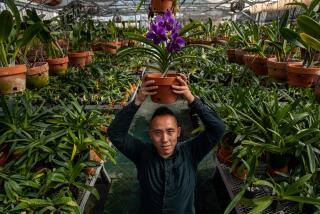PLANTS : Hybrid Gardening Brings East and West Together
- Share via
“Oh, East is East, and West is West, and never the twain shall meet,” wrote Kipling a hundred years ago. Not so, when it comes to gardening.
Though distance, water and culture kept the gardening worlds of the East and the West separate for millennia, the gap began to narrow just over 200 years ago.
The first plants to trickle out of China were those that were most accessible to foreigners--cultivated plants growing in and around seaport towns. It was not until the middle of the 19th Century that explorers pressed inland to open wide the treasure chest of wild and cultivated plants.
These plant explorers are honored in plants that bear their names: Fortunella spp., or kumquats, named for Robert Fortune; Citrus meyerei, the Meyer lemon, named for Frank Meyer, and Sinowilsonia spp., named for E.H. (Chinese) Wilson.
From the Far East came plants for which there were no Western counterparts, such as the gingko tree. There also came plants that were more, or at least equally, valuable as those in the same genera found in the West. Whereas we have species of juniper, called red cedar (Juniperus virginiana), from China comes the Chinese juniper (J. chinensis). Our juniper turns drab brown in winter, but the Chinese species maintains its lush green color throughout the year.
Common witch hazel (Hamamelis virginiana) and the vernal witch hazel (H. vernalis) are shrubs of American forests, and Oriental forests likewise are home to Oriental species: the Chinese (H. mollis) and the Japanese (H. japonica). The Oriental species blossom at different times than do the American species, so they are useful for extending the period of witch hazel bloom.
Where East really does meet West in gardening is in hybrids of Oriental and Occidental species. The hybrid tea rose, grown in American gardens, is one example. “Tea” in the name traces back to a tea-scented rose (Rosa odorata) from China.
For centuries, the Chinese hybridized this summer-flowering climber having huge yellow flowers with a dwarf form of another species, R. chinensis. In the 19th Century, these hybrids were further hybridized with European roses to make hybrid tea roses.
American plant breeders sometimes have had to look across the Pacific to find plants with resistance to diseases originally brought to America from the Orient.
Chestnut blight turned up at New York’s Bronx Zoo in 1906, and within 50 years the American chestnut (Castanea dentata) was dead or dying in 7 million acres of Appalachian forests. Japanese chestnut (C. crenata) and Chinese chestnut (C. mollisima) have evolved with the blight, and so have some resistance to it. They have been hybridized with the American species to produce blight-resistant trees.
Plants of the Orient have even been useful in providing resistance to diseases not originating in the Orient. Fire blight disease of pears was first noted in New York’s Hudson Valley at the end of the 18th Century. Some Oriental pear species are resistant to fire blight.
More than 100 years ago, hybrids between Oriental and European pears were produced--at first by accident--which showed some resistance to blight. These original hybrids did not taste very good but did make pear-growing possible in the blight-prone southeastern United States.
The story is not yet over. Especially in recent decades, the West has sent technical expertise in horticulture across the Pacific, while the East continues to yield “new” plant treasures.






